Making Ash: A peek behind the scenes
About a year ago I was having some painting done in my house and I had the following conversation with my painter:
"So, I'm just going to run out to the back yard for a little while, if you see smoke and fire, don't worry about it."
"Um, OK."
"You see, tomorrow is Ash Wednesday and I need to burn these palms in order to make ashes so that tomorrow I can smear them on people's foreheads, look them in the eye, and remind them they are going to die."
Short pause.
"Your job is really weird. Good. But weird."
My job is weird. Good. But weird.
There are all sorts of traditions and practices connected to Lent and Holy Week in the Anglican Church but today I thought I'd walk you through the life cycle of a palm.
First, there is an entire part of this story that I don't really know anything about. For those of us who live in parts of the world where we can't easily grow palms we rely on someone else to grow them and ship them to us. We buy ours from a local church supply shop, but a friend of mine in North Carolina told me that her church just heads out into the brush behind the church and cuts down as many as they need.
On the Saturday before Palm Sunday, members from the two church congregations that share the building gather together to fold palms. (saint benedict's table rents space in All Saints' Anglican Church. We are two separate congregations but we look to work together whenever it makes sense to do so.)
At this point the palms are green and wet and relatively easy to fold. Every year I need to re-learn the process but gradually muscle memory kicks in and I can fold the palms without really thinking too much about it.
At our church we fold the palms into simple crosses, but a google search will show you palms transformed into amazing works of art.
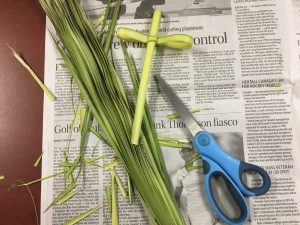
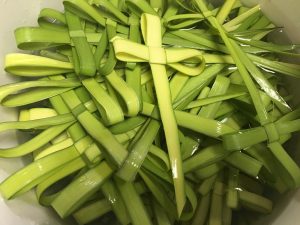
But why do we fold palms in the first place?
One way to answer the question is to point out that when Jesus entered Jerusalem people waved palm branches and we remember this event in his life on Palm Sunday. (Click here to read last year's Palm Sunday sermon for more details.)
But for me, folding palms goes deeper than a simple commemoration of an event. You can easily have a Palm Sunday service without spending time and money folding palms.
I have spent my whole life in churches and, while I never heard anyone say this using these exact words, the churches I was raised in believed it was much more important to ensure I had Jesus in my head than my heart.
Being a Christian meant I needed to learn a series of ideas and agree that I believed they were true. It was all about my head.
And those ideas were reflective of a particular way of understanding who Jesus was - a Jesus who was seen through the lens of white, colonial, heteronormative patriarchy.
I'm only just now beginning to come to see just how damaging that was.
One of the ways that this "inviting Jesus into my head" form of Christianity has been damaging is it ignores the diverse experiences of the people God created. God created people who are nonverbal, people who will never be able to read or process complex Statements of Faith, people whose first language and ways of connection is through dance and their bodies or the visual arts and surely God wants to be in relationship with these people too.
Which means that there have to be more ways to connect with God than the methods that the churches I grew up in privileged.
So now I try to find as many ways as possible to help people connect. Touching, smelling, and folding palms connects us to God. Holding them in our hands during the Palm Sunday service as we move our bodies, sing, speak, and listen amplifies that connection.
After the service people will take those crosses home and tuck them in a prayer book, or the corner of a picture frame or a window sill. They will quickly shrivel and dry as we move through the early days of Holy Week but they'll remain in those spots through the year until we are all reminded a week or two before Ash Wednesday to return them to church to be burned.
The year I was shown how to turn palms into ashes I was overtaken by geeky joy, but this year I almost missed the beauty of the moment in my busyness. I was about to just try and quickly burn the palms before rushing off to the next thing on my to do list when I was overtaken with the difference a few short years could make on my attitude.
So I stopped, collected myself and entered prayerfully into the process. I collected all my supplies - dried palms, several metal bowls, a lighter, a spoon, and a sieve. This year I also experimented with cutting the palms into smaller pieces before I began. When the flame hits long curly palm branches the fire can become unruly and hard to control.
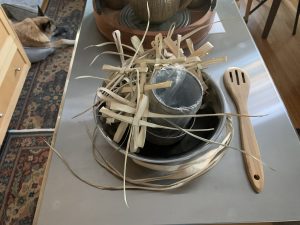
I went outside and placed the bowl with the palm pieces in the snow on top of my raised vegetable garden. My garden is in its own Lenten season - dormant and dead, but in a few short months it too will be filled with new life.
As I watched the smoke billow out of the bowl I thought of all the people who had folded, saved, and returned those palms. I thought of the people who would come to our Ash Wednesday liturgies and a feeling of gratitude enveloped me that was thicker than the smoke.
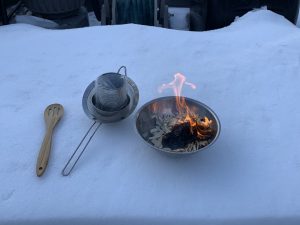
Once burned, the palms need to be pressed through a sieve to break up any larger pieces and make them suitable for marking people's foreheads with a tangible sign of their mortality.
"Remember you are dust and to dust you shall return."
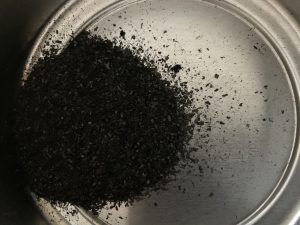
The first ashes, however, were dispersed earlier then they should be. It happens every year but I always forget to watch for an unexpected gust of wind that will appear out of nowhere as I pass the ashes through the sieve, disbursing them throughout my neighborhood.
Which is as it should be.
I Hate the Mall
How do you celebrate Advent?
Advent is one of my favorite seasons in the church year. I love how it allows me to slow down and live in ways that are out of step with the culture during a season that can be particularly fraught with anxiety and busyness. I hate the mall at the best of times, but especially in December.
A number of years ago my church produced a book of readings and a series of podcasts for Advent. As I was preparing to preach yesterday I was reminded of that experience. It was the first time I'd ever been in a sound booth or experienced what it was like to be produced by a professional sound engineer. I hope you enjoy them.
Click here to listen to the podcast.
Click here to purchase our Advent e-book.
Take the Doughnut
I’m not exactly sure when I first read Amanda Palmer’s book,The Art of Asking: How I Learned to Stop Worrying and Let People Help, but it was likely during the winter of 2015.
I blogged about the book in the spring of 2015 when I was delighted to come across a street performer dressed as a bride on the streets of Paris a few days before I headed out to walk the Camino de Santiago.
I re-read it about once a year.
And by “read” I actually mean listen, because I prefer the audiobook to the physical one.
Amanda’s voice infuses the text with warmth and humour and she periodically breaks into song. Plus her Neil Gaiman impression is delightful.
I re-listen to the book about once a year because I think it’s one of the best books on pastoral ministry I’ve ever read.
If you know anything about Amanda that may surprise you, it might surprise her even, but that doesn’t make it any less accurate.
In the book, she talks about Henry David Thoreau and the myth of the independent artist.
You may, like me, be most familiar with Thoreau’s work because it’s quoted in the film Dead Poet’s Society. He’s Mr. “live deep and suck out all the marrow of life.”
He’s also famous for writing about his choice to withdraw from society and live alone on the banks of Walden Pond.
But do you know the truth?
He wasn’t all that independent.
He borrowed the land from a rich neighbour. His friends had him over for dinner regularly and the women in his life delivered freshly baked goods every Sunday.
His mother and his sister brought him food every Sunday, including freshly baked doughnuts.
Doughnuts.
Mr. “I went to the woods to live deliberately, to front only the essential facts of life…” may have written those worlds while munching on a freshly baked doughnut. A doughnut he didn’t make or even leave his desk to go buy. It was delivered right to him.
Amanda then makes a strong and impassioned case that we should all learn to take the doughnuts.
People want to help, she argues. So learn to ask. And learn to accept help when it’s offered.
Take the doughnut.
As I am writing this I am also sitting next to a body of water but I’m no more independent than Thoreau.
The cabin belongs to friends, and my mom delivered a care package full of food to my home just before I left to come here. (No doughnuts, but there was a package labelled “spinach brownies.” If you think I am funny, you should meet my mom. She’s hilarious.)
I took the help that was offered. It’s not easy, but I’m learning.
You may not know it, but you actually have a doughnut and I’m asking you to share it with me.
I have written 1.23 books, neither of which are published. You can read more about the first book here.
People who know about these things say that they’re good. Publishable. Worth reading.
But in the modern publishing world, that’s not enough. Publishers also need to know that there is a critical mass of people who want to buy a book before they will be willing to publish that book.
And here’s where you come in.
I need to build the biggest list of potential readers that I possibly can.
You can be one of those readers.
I’m asking you to go to my website and sign up for my email list.
You’ll get periodic updates and I’ll never share your information with anyone.
This is the single more effective way to support my work. It’s not just any doughnut, it’s a doughnut with sprinkles on top.
And I’m asking you to share it with me.
Pastoring While Female: Right Gifts, Wrong Package
The monk with the kind eyes…
Stop it.
The monk with the kind eyes…
Seriously, that’s enough.
The monk with the kind eyes…
This is NOT funny.
The monk with the kind eyes…
Fine. I give up. I’ll write the story of the monk with the kind eyes. The monk who, by asking one innocent question, unveiled multiple layers of trauma and changed the trajectory of my life forever.
In the winter of 2016, I spent a few months as a short term scholar at the Collegeville Institute researching and writing about the varied ways that Benedictine spirituality has influenced my life and work.
As part of that process I committed to praying the Daily Office with the monastic community at St John’s Abbey. 2-3 times a day I put down whatever I was doing, put on layers and layers of winter clothing and trudged up the hill to the church.
I loved praying with the community, and I miss it to this day, but I also hold them responsible for inspiring me to write a book I definitely didn’t want to write.
We’d pray and I’ve leave to go back to my apartment to resume work on my project but instead of lines from the psalms or a new research question, I would find myself mulling over the same line again and again and again: “The monk with the kind eyes…”
I made a valiant effort to shake off that line and the accompanying story from my own life, but finally it because clear that the only way to get the story out of my head was to put in onto the page.
I had no idea that it would become my book Pastoring While Female: Right Gifts, Wrong Package.
But it did. And I’m looking forward to being able to share this book with as many people as possible.
Pastoring While Female: Right Gifts, Wrong Package is a work of narrative nonfiction which, as the title suggests, tells the story of how I first became a pastor in a denomination that didn’t believe women could be pastors and then later found my way to the Anglican Church. In the specifics of my story are the universal experiences of many women whose lives take them outside of the expectations of traditional gender roles.
As a kid, I could imagine travelling to far-off kingdoms like the heroes in my favourite fantasy novels, but I could never have imagined becoming a pastor. Growing up in the Mennonite Brethren Church, a denomination that historically has not allowed women to be pastors, I simply wanted to love Jesus and help people. I’m not sure who was more surprised, me or my denomination, when I wound up serving as a pastor for almost 17 years before eventually leaving to pursue ordination in the Anglican Church of Canada.
This work of creative nonfiction tells the story of my unfolding understanding of my vocation and the challenges I’ve faced along the way as I’ve encountered people and institutions that were either unprepared or unwilling to accept that a woman could be a pastor. The narrative is supported with pilgrimage experiences—I travel to a Winnipeg monastery, where I learn about labyrinths; the Puye Cliffs and Chimayo in Santa Fe, New Mexico; St John’s Abbey in Collegeville, Minnesota; the Camino de Santiago; and to Banff and Calgary—and these pilgrimages help me process my vocational questions. The book is also quirky and humorous, featuring pop culture references throughout.
Although the book is finished I am now navigating the world of publishing and that takes time and patience. In the meantime, I’m also working on a second book.
If you sign up for my email list you’ll be the first to learn of any new developments on the publishing front and you’ll also be helping make it possible for me to find a publisher. Publishers want to know that there are people who are actually interested in buying a book and so the bigger my email list, the more likely it is that the book will be published.
And in the meantime, I will continue to work on my new book and will share snippets of that work and other related content. I’m looking forward to the conversations it will spark and the community that will develop in the process.
Where have all my footnotes gone?
Hello folks,
I've been hard at work this week uploading content to the website and it seems that in some of my sermons the footnotes have disappeared. It's important to me to properly acknowledge other people's work so I'm hoping to be able to add them back in over the next few weeks.
In the meantime, if you find something I reference and you want to know how to find it, let me know.
Camino 2015

In 2015-16 I took a two part sabbatical. I walked the Camino Santiago in the spring of 2015 and then spent the first two months of 2016 at the Collegeville Institute in Collegeville, MN. It was there, while working on a different project, that the idea for my first book first came to me.
I blame the monks.
I blogged every day while I was on the Camino and periodically when I was in Collegeville. You can check it out by clicking here.
My book Pastoring While Female: Right Gifts, Wrong Package has not been published but if you add your name to my email list you'll be the first to know when it is!